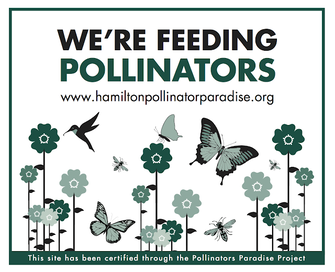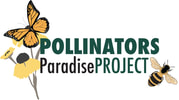
As part of the Hamilton Pollinator Paradise Project we offer a free certification program - we'll add your location to the growing map of pollinator habitat across the City and you'll receive a free "We're Feeding Pollinators" sign for your garden!
Pollinator gardens provide food, shelter, and nesting locations in urban and suburban areas where natural habitat is scarce. Adding your pollinator patch to the map helps us visualize the habitat corridor growing across the city and encourages others to join the movement.
You can certify your pollinator garden at any point in your gardening journey - from newly planted to established and thriving. We are focused on how your garden helps pollinators more than how it looks!
How to Apply
1) Create a pollinator garden - you can start one from scratch or add native plants to an existing garden. Our online toolkit is a great resource for creating a pollinator paradise.
2) Complete the application - we'll ask you questions about the garden size, plant species, habitat features, and maintenance practices to ensure you are certifying a pollinator-friendly garden. You can also submit photos of your garden!
3) Receive confirmation and pick up your sign - you will receive a follow-up email in 1-2 weeks with confirmation that your garden has been certified. Instructions on how to pick up a weatherproof "We're Feeding Pollinators" sign to display in your garden will be provided.
Pollinator gardens provide food, shelter, and nesting locations in urban and suburban areas where natural habitat is scarce. Adding your pollinator patch to the map helps us visualize the habitat corridor growing across the city and encourages others to join the movement.
You can certify your pollinator garden at any point in your gardening journey - from newly planted to established and thriving. We are focused on how your garden helps pollinators more than how it looks!
How to Apply
1) Create a pollinator garden - you can start one from scratch or add native plants to an existing garden. Our online toolkit is a great resource for creating a pollinator paradise.
2) Complete the application - we'll ask you questions about the garden size, plant species, habitat features, and maintenance practices to ensure you are certifying a pollinator-friendly garden. You can also submit photos of your garden!
3) Receive confirmation and pick up your sign - you will receive a follow-up email in 1-2 weeks with confirmation that your garden has been certified. Instructions on how to pick up a weatherproof "We're Feeding Pollinators" sign to display in your garden will be provided.
Certification Criteria
A pollinator paradise will include everything a pollinator needs to complete its lifecycle - food, shelter, and nesting/overwintering sites. We're looking for your pollinator garden to have plants and habitat features that pollinators need to thrive year-round.
Size: Pollinator gardens come in many shapes and sizes, from small containers to entire landscapes covered in pollinator-friendly plants and habitat features. There is no minimum area requirement in order to certify your habitat, but if possible we recommend aiming for at least 9m² (100ft²).
Plants: Native pollinators have evolved alongside native plants for thousands of years, making native plants the most beneficial for pollinators. We're looking for at least 50% of your plant species (wildflowers, grasses, shrubs, trees) to be native; the more plant diversity the better! Adult pollinators need food throughout the growing season so aim to have flowers blooming across spring, summer, and fall. We also want to know how you're managing invasive species in the garden.
Shelter & Nesting/Overwintering Sites: Pollinators need places to hide from predators and the weather, sites to build nests or lay their eggs, and areas to tuck into for the winter. Features we look for include bare ground, hollow stems, branch or brush piles, rocks, logs, shrubs, and tall grasses.
Water: Some pollinators need water sources like puddles, flat rocks, a shallow dish with rocks, or a water feature.
Maintenance Practices: How we maintain our gardens can impact pollinators and the greater environment - are you adding more native plants, water sources, or shelter/nesting features over time? Do you manage invasive species? Do you use mulch or a rain barrel in the garden? Do you leave dead stems and leaves for pollinators to overwinter in? Do you use pesticides?
A pollinator paradise will include everything a pollinator needs to complete its lifecycle - food, shelter, and nesting/overwintering sites. We're looking for your pollinator garden to have plants and habitat features that pollinators need to thrive year-round.
Size: Pollinator gardens come in many shapes and sizes, from small containers to entire landscapes covered in pollinator-friendly plants and habitat features. There is no minimum area requirement in order to certify your habitat, but if possible we recommend aiming for at least 9m² (100ft²).
Plants: Native pollinators have evolved alongside native plants for thousands of years, making native plants the most beneficial for pollinators. We're looking for at least 50% of your plant species (wildflowers, grasses, shrubs, trees) to be native; the more plant diversity the better! Adult pollinators need food throughout the growing season so aim to have flowers blooming across spring, summer, and fall. We also want to know how you're managing invasive species in the garden.
Shelter & Nesting/Overwintering Sites: Pollinators need places to hide from predators and the weather, sites to build nests or lay their eggs, and areas to tuck into for the winter. Features we look for include bare ground, hollow stems, branch or brush piles, rocks, logs, shrubs, and tall grasses.
Water: Some pollinators need water sources like puddles, flat rocks, a shallow dish with rocks, or a water feature.
Maintenance Practices: How we maintain our gardens can impact pollinators and the greater environment - are you adding more native plants, water sources, or shelter/nesting features over time? Do you manage invasive species? Do you use mulch or a rain barrel in the garden? Do you leave dead stems and leaves for pollinators to overwinter in? Do you use pesticides?
